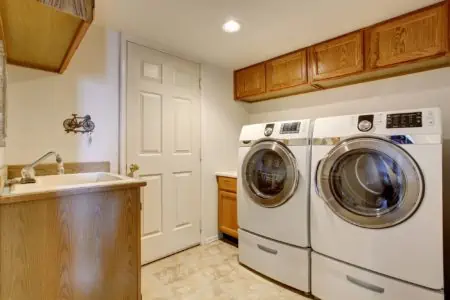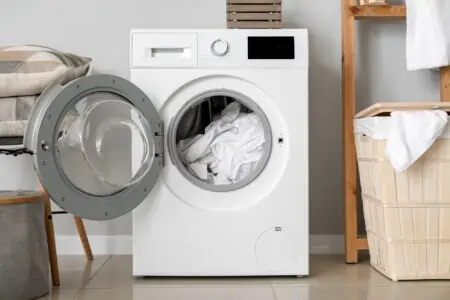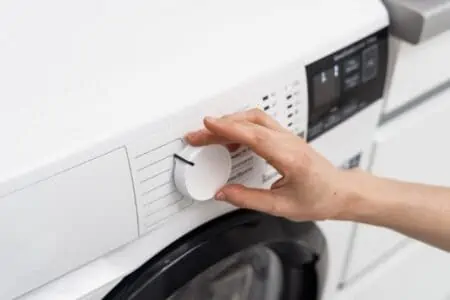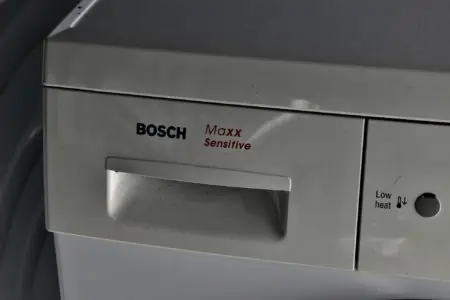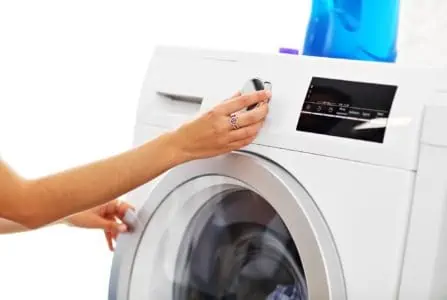The most important aspect to look at when buying and installing a new washer and dryer is the size of the appliances. You must have enough space for them.
If you’re wondering where to install your new appliances, you’re probably asking how wide a washer and dryer is?
We’ll walk you through the average sizes for various types of washers and dryers. We’ll also show you how to measure for your new appliances, plus top tips for getting them into small spaces.
By the end, you’ll be able to find the right appliances for you and know how to best position them in your home.
Key Takeaways
- Full-size washers and dryers are 27 inches wide, while compact machines are 24 inches wide, and mega-capacity machines are 28-30 inches wide.
- Leave one inch on either side and six inches at the back for airflow and plumbing when installing your appliances.
- Measure the width, height, and depth of the space for your washer and dryer, considering extra space for airflow and door clearance.
- For small spaces, consider compact appliances, washer-dryer combos, or stackable options to save space.
How Wide Is a Washer And Dryer?
Depending on the type of washing machine and the brand, washer and dryer dimensions vary. However, the average width for full-size washers and dryers is usually 27 inches. In feet, that’s 2.25 feet.
Washing Machine Sizes Chart
To make it easy for you, we’ve put together a chart that lists the average dimensions for different washing machine types. This includes compact machines, full-size machines, and mega-capacity machines. Note that there’s no standard size, so always check the size of the specific model that you’re buying.
| Type | Compact | Full-Size | Mega-Capacity |
| Width | 24 inches | 27 inches | 28-30 inches |
| Height | 34 inches | 35-39 inches | 40-42 inches |
| Depth (with the door closed) | 24 inches | 28-34 inches | 32-34 inches |
| Depth (with the door open) | 42-44 inches | 50-57 inches | 55-56 inches |
Please Note
The depth measurements don’t include the standard 4-inch venting. Standard dryer vents are 4 inches big, so you must factor in an extra 4 inches of clearance at the back of the machine. To make it easier, add 4 inches onto the depth to conclude the final depth, including the vent.
Standard Washer and Dryer Sizes
As mentioned, there are various washer and dryer dimensions. We’ll walk you through the average dimensions of various types of machines so that you know what to expect depending on the kind you’re considering.
- Side-by-side: 27 inches wide, 35-39 inches high, and 28-43 inches deep (with the door closed).
- Stackable: They average at 27 inches wide, 77-80 inches tall, and 30-34 inches wide.
- Compact: 24 inches wide, 34 inches high, and 24 inches deep (with the door closed).
- All-In-One: Front loading combos average at 23-27 inches wide, 33-39 inches tall, and 22-30 inches deep (with the door closed).
- Large capacity: Large or mega-capacity machines tend to be 28-30 inches wide, 40-42 inches tall, and 32-34 inches deep (with the door closed).
- Front Load: 27 inches wide, 39 inches tall, and 32-34 inches deep.
- Top Load: 27 inches wide, 42-44 inches tall, and 27-28 inches deep.
Other Size Considerations
While we’ve explained the standard washer and dryer sizes, some details can alter the dimensions. This includes:
- Pedestals: If you’ve opted for pedestals, this will automatically make your washer and dryer taller. On average, this can add 10-15 inches to the overall height.
- Stacking: If you’ve not bought a stackable unit but want to stack your appliances, this will obviously make the entire unit taller. However, it will also take up less width than installing the appliances side-by-side.
How to Measure For a New Washer and Dryer
Once you’ve figured out how wide your washer and dryer are, and the other important dimensions, you need to measure for the appliances.
Unfortunately, just knowing the width, depth and height aren’t enough. You have to take into consideration some other factors.
Firstly, you have to consider the airflow needed. Once you know the machine’s width, you must add one inch to each side of the appliance to ensure adequate airflow. This includes one inch on both outer sides and one inch between the appliances if you’re placing the appliances side-by-side.
Next, you must add at least six inches to the depth of the machine. This gives you space for the vent and water hookups at the back of the appliances.
Finally, focus on the height. For top loading machines, you need at least 20 inches above the machine so that the lid can fully open. For front loading machines, ensure there’s enough height above the machine if you’re adding pedestals. If you’re slotting the appliance underneath a countertop, we recommend about ½ inch so that it can glide in and out without obstruction.
You must also consider the depth when the door is open to allow you to freely open and close it without issue.
Tips For Fitting a Washer and Dryer Into a Small Space
If you’re living in tight quarters, there are a few hacks you can try. Keep these things in mind to make installation easier:
- Consider the brand: We definitely recommend a compact appliance over full-size or mega-capacity. On that note, consider brands like LG, Bosch, or Miele. They create appliances that max out at 24 inches wide.
- Always check the door-open depth: You may find a washing machine or dryer that sounds like the perfect fit. But always take the measurements with the door open. It would be a disaster if you installed your new appliances and couldn’t even open the door!
- Check the drum capacity: The appliance measurements are important but don’t forget to check the drum capacity. You should take the biggest possible capacity to size ratio to ensure that you can wash an adequate amount of clothes at once. For instance, look for a machine with roughly three cubic feet as its capacity. This can fit around 12 pounds of laundry per load.
- Choose a combo: If you don’t have enough space for both a washer and a dryer, opt for a washer-dryer combo. You can wash and dry your clothes in these machines. They’re not the greatest at drying clothes quickly — but they are better than air-drying your clothes for days on end!
- Go stacked: If you want two separate appliances, opt for a stackable option. Or you can buy two separate appliances and stack them yourself. This will save more space since you’re utilizing the excess height in your home.
FAQs
Measure for Good Measure
When you find a washer and dryer you love, it’s important to take measurements. If you skip this step, you could end up with machines that don’t fit in your home.
Always ask how wide the washer and dryer is? Will it fit? Is there enough room on all three sides for ventilation?
Don’t forget that washers and dryers come in all kinds of sizes. So you’ll be able to find the right fit, whether you have a large mansion or a tiny studio apartment.
